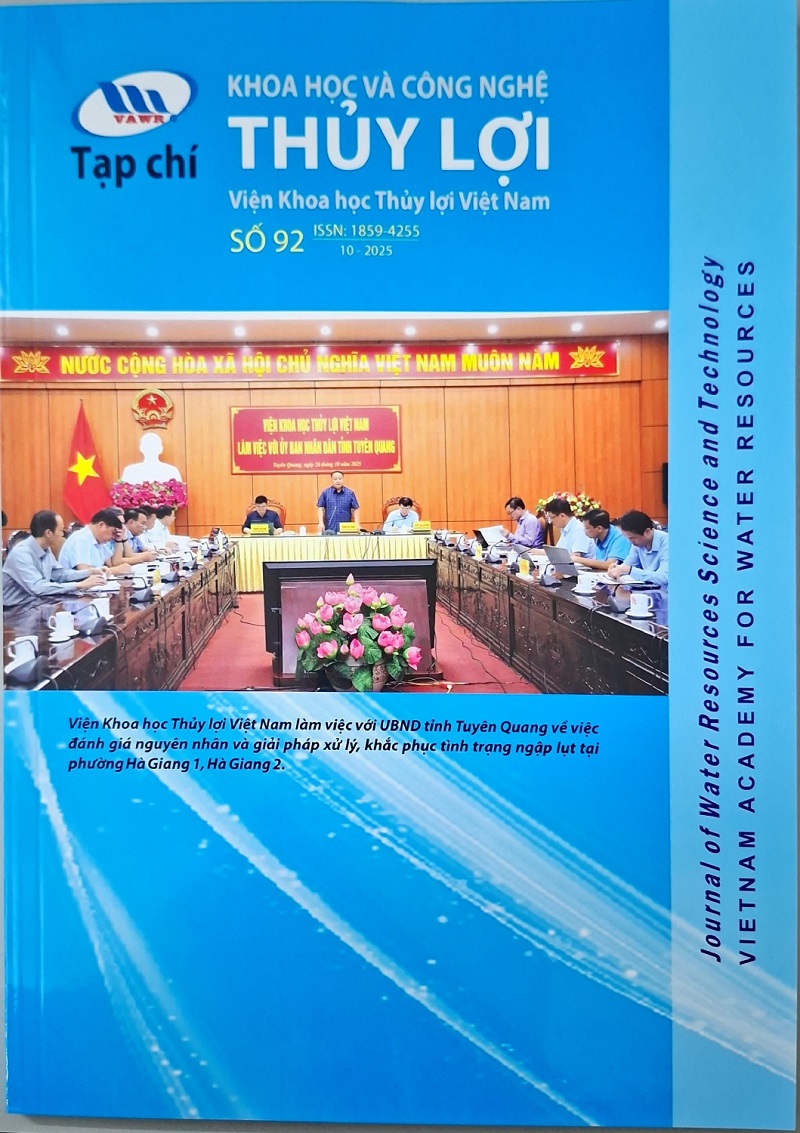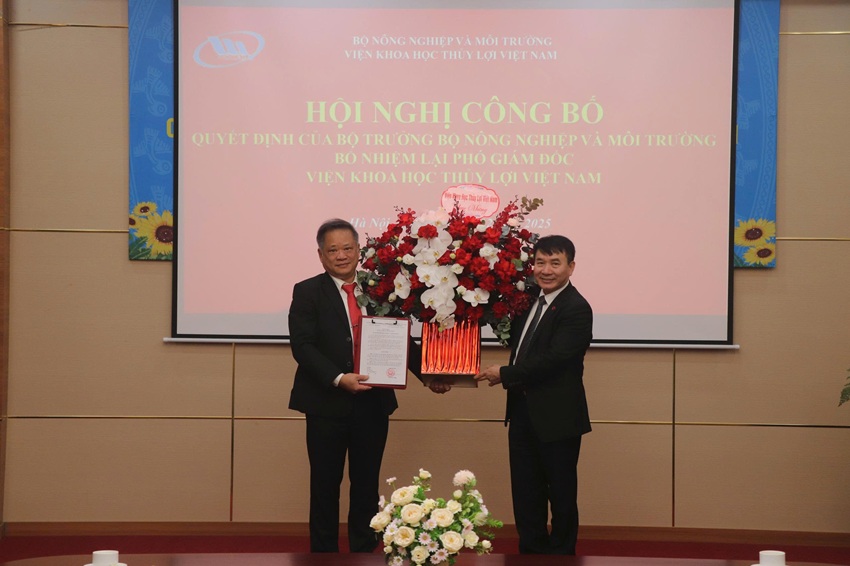Performance Assessment of Irrigation Schemes and Water Pollution Issues Raised in the Red River, Vietnam
28/08/2021Irrigation schemes management in Red River Delta, Northern Vietnam has an extreme significance to ensure the multi-objective water supply and the health of the Red River. This study is drawn upon mostly primary data sources including results of water supply assessment of economic industries and the status quo of hydraulic works (pumping station, canals, gates, regulating reservoirs, etc.) along the Red river (study area inside the territory of Vietnam), then compare the results against the value of water supply capacity of irrigation schemes in the context of effectiveness of hydraulic works has not yet achieved as original designs (approximately 60%). From that point, identifying the relationships between - trade off - the water supply and healthy of the Red river. The results of the comparison show that the water supply for agriculture production will increase dramatically in 2020 approximately from 8 bill.m3/year compared to actual demand of about 13.65 bill.m3/year. And, more irrigation water may be more harmful for the Red river’s health, which is absolutely correct in the context of irrigation schemes also supply for other sectors such as industry, drinking water, aquaculture farms, etc. The results of this study are conclusive evidence to promote the implementation of a number of water policies in the Red River Delta.
1. Introduction
2. Research Methods
2.1. SWOT Analysis Method
2.2. Method of Water Demand Calculation
2.2.1. Water Demand for Crops
2.2.2. Water Demand for Breeding
2.2.3. Water Demand for Fishery
2.2.4. Water Demand for Industry
2.2.5. Water Demand for Drinking Water
2.2.6. Water Demand for Environmental Flow
2.3. Methods of Performance Assessment of Irrigation Scheme Management
3. Research Results
3.1. Water Demand Calculation Results
3.2. Assessing the Status Quo of the Performance Assessment of Irrigation Schemes in RRD
3.3. Assessing the Drainage Water Quality at Two Drainage Gates Along the Red River
4. Discussion
5. Conclusions
References
[1] Department of Water Resources Management, “National Environment Report 2012 - Surface water environment,” Ministry of Natural Resources and Environment of Vietnam, Hanoi, Vietnam, pp. 3–8, 2012.
[2] T. T. Nghia, “Flood management flood management in the Red – Thai Binh River Basin, Viet nam,” Institute of Water Resources Planning of Vietnam, Hanoi, Vietnam, pp. 2–3, 2006.
[3] N. T. Nga, “Green transportation oriented management of road networks in provincial cities of type in the Red River Delta,” Hanoi Archtectural University, Hanoi, Vietnam, p. 8, 2017.
[4] IGU/LUCC North East Asia Conference 2009, “Land cover and land use change in North East Asia: Problems of sustainable nature management,” International Geographical Union, Vladivostok, Russian, pp. 45–46.
[5] N. Van Diep, N. H. Khanh, N. M. Son, and N. Van Hanh, “Integrated water resources management in the Red River Basin - Problems and Cooperation opportunity,” Paper presented at the International conference on Adaptive and Integrated water management, Basel.
[6] P. T. Anh and K. Shannon, “Water Management in Vietnam Indigenous Knowledge and International Practices: The Case of the Red River Delta,” Northern Hydraulic Planning Institute of Vietnam, Hanoi, Vietnam, pp. 1–3, 2010.
[7] Directorate of Water Resources, “Approving the survey on management, exploitation and use of irrigation schemes,” Ministry of Agriculture and Rural Development of Vietnam, Hanoi, Vietnam, pp. 2–9.
[8] Ministry of Agriculture and Rural Development, “70 years 1945-2015, irrigation schemes in Vietnam,” Labour Publishing House, Hanoi, Vietnam, pp. 17–23.
[9] N. D. Viet and D. T. Tu, “Rationale for implementing the irrigation management transfer that aim to improve efficiency of water supply and river’s health case study: Red River Delta,”International Conference: Mekong, Salween and Red Rivers: Sharing Knowledge and Perspectives Across Borders, Faculty of Political Science Chulalongkorn University, Bangkok, Thailand, pp. 2–3.
[10] C. Jolk, S. Greassidis, S. Jaschinski, H. Stolpe, and B. Zindler, “Planning using integrated water Red River Basin,” University of Bochum, Bochum, Germany, pp. 711–725.
[11] L. K. Truyen, “Scientific basis and operating practices for water supply in dry season of Red River Delta,” Ministry of Science and Technology of Vietnam, Hanoi, Vietnam, pp. 45–60, 2008.
[12] Asian Development Bank, “PCR Viet Nam - Second Red River Basin Sector Project,” Ministry of Agriculture and Rural Development of Vietnam, Hanoi, Vietnam, 2012.
[13] W. Gretzky, “Strategic planning and SWOT analysis,” Health Administration Press, Canada, pp. 91–97, 2010.
[14] Directorate of Water Resources, “Benchmarking - Decision No. 2212/QĐ-BNN-TCTL,” Ministry of Agriculture and Rural Development of Vietnam, Hanoi, Vietnam.
[15] Centre for Evaluation and Monitoring, “Environmental water report,” Ministry of Natural Resources and Environment of Vietnam, Hanoi, Vietnam, pp. 67–100, 2014.
[16] Directorate of Water Resources, “Water fee report,” Ministry of Agriculture and Rural Development of Vietnam, Hanoi, Vietnam, 2015.
See detail: Performance Assessment of Irrigation Schemes and Water Pollution Issues Raised in the Red River, Vietnam
Nguyen Duc Viet1, *, Dao Trong Tu2, Nguyen Tung Phong3, Ha Hai Duong4
1Directorate of Water Resources - Ministry of Agriculture and Rural Development, DWR, Hanoi, Vietnam
2Centre for Sustainable Water Resources and Climate Change, CSWRCC, Hanoi, Vietnam
3Vietnam Academy for Water Resources, VAWR, Hanoi, Vietnam
4Institute for Water and Environment, IWE, Hanoi, Vietnam
International Journal of Environmental Protection and Policy
Ý kiến góp ý:









